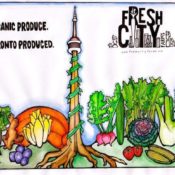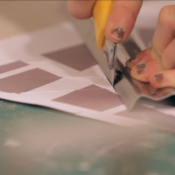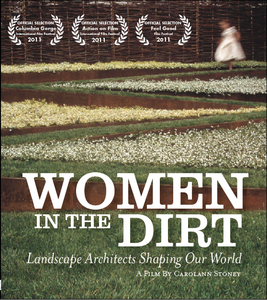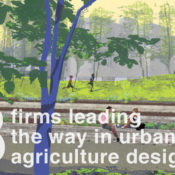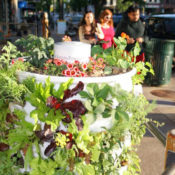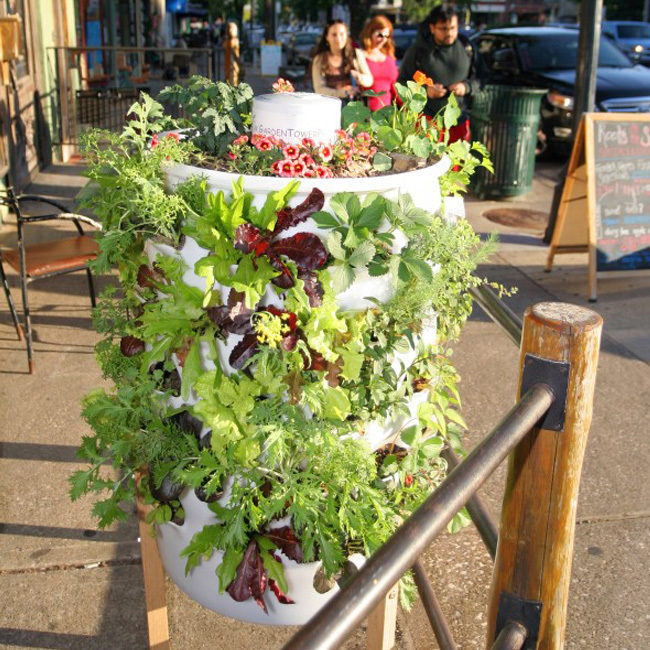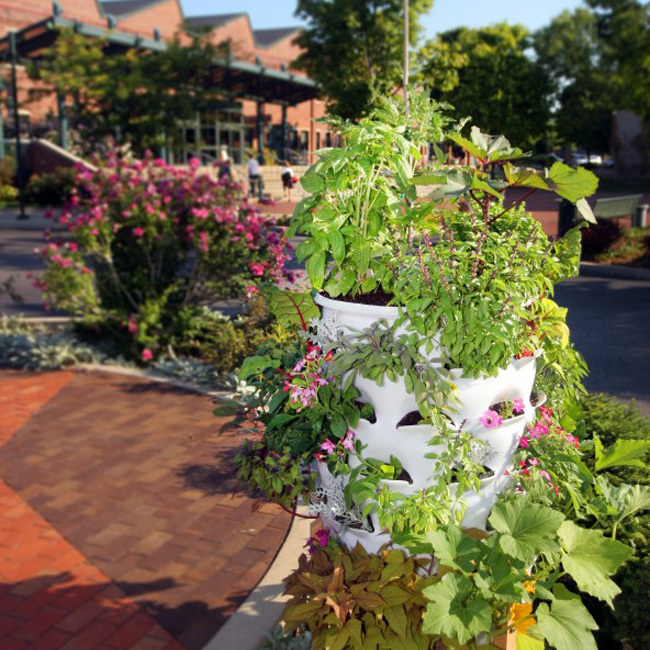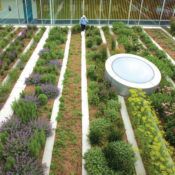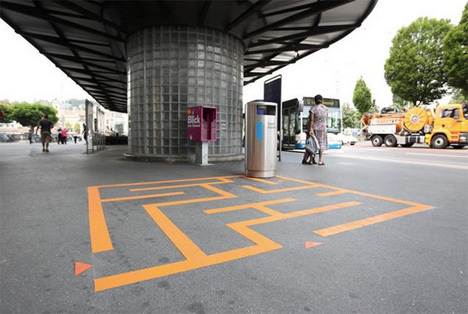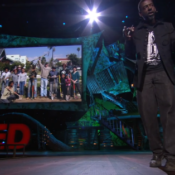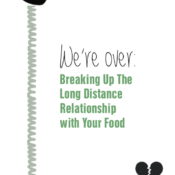Author: Abbagail Jewel Taddei
Urban Agriculture Series #6: Interview with Ran Goel – Fresh City Farms Founder
As one of the very first urban farms I discovered, Fresh City Farms in Toronto holds a special place in my heart. So it was with great excitement that I was finally able to sit down and interview Ran Goel, the Fresh City Farms Founder who perfectly captures the energy and spirit of FCF’s mission. In my interview, I asked Ran about FCF’s role in urban agriculture and its relations to landscape architecture. Read on for the full interview!
Example of the fresh produce and recipe card in the weekly food bags.
Fresh City Farms is Toronto’s ultimate urban food producer. With a mission to “create and perfect new ways to connect food makers and eaters,” the organization does an excellent job teaching, challenging and encouraging the urban community. Going above and beyond your average Community Supported Agriculture program, FCF offers a number of volunteer and educational opportunities to empower people to make healthier decisions about their food.
Founder, Ran Goel at the Farm Lot Premier in Toronto.
Five years ago, urban agriculture was not as popular as it is today. Fresh City Farms was the first of its kind in the urban food movement and delivery of local foods. How/why did you get into this? What was the catalyst for change into this lifestyle?
At the very core, we are connecting people with land and food production. What attracted me to city farming was the idea of moving beyond reason so to speak — to basically plant an edible garden and let people join you. They may grab a shovel; they may just watch or perhaps just buy what you grew. But they won’t be the same. It’s a way of empowering people by encouraging them to join or at least bear witness to the act of creation. So the question for me from the start was — how do we make this happen on a larger scale? Everything that followed is really to make it economically feasible.
A few weeks ago, FCF, with the help of TAS and The Detox Market, had an urban farm premier called ‘The Farm Lot.’ It was an amazing event, local food and artisanal vendors, and container gardening in the city. Can you tell us more about that and what you hoped it would accomplish?
We are looking to get food production in front of people, so that they don’t just see ads all day urging them to consume. Partnering with TAS has been our initial attempt at creating a Fresh City style ad. Successful city farming ultimately depends on key partnerships relating to land. We cannot economically compete with other uses of land — that’s why there’s no farming in the city in the first place. So we have to be creative in securing land to both grow and to promote what we do. With TAS, there was a great fit where they had this unused vacant lot and a culture of embracing community into their developments.
The Farm Lot Premier in Toronto, painted wall, which can still be found at 369 King Street West.
What’s going on with FCF? Any new projects? Future events? Progress?
Lots going on. You got to keep swimming or you’ll sink. We are focusing on several areas for the next few months. One is extending and improving our educational efforts through workshops for the public. Another is further fine tuning our member farmer program, which is the cornerstone of our efforts to help seed a new generation of farmers. We are also constantly looking to improve our produce bag members’ experience. Look out for a new book highlighting the environmental, social and economic impact of growing carrots the right way versus the wrong way. As for events, we are always planning the next event, just check out our Facebook!
Tell us about the recent location expansion, and what you have on the new grounds.
We are actually still farming the plot at Downsview Park, which we started with three years ago. We do now have an additional acre at the south end of Downsview Park, which will take some time to really build up as the soil was not in the best shape when we started growing there. We are also growing at Black Creek Community Farm as part of our partnership there.
As you know I am a recent graduate of the landscape architecture program. Do you think urban agriculture has anything to do with landscape architecture and design? High or low correlation?
Very high! Making food production ubiquitous is everyone’s job, not least landscape architects. Food production has to be embedded into the planning, development and re-development process by everyone around the table. Edible landscaping often won’t even be on the menu unless the LA points it out as a potential option.
Have you used a landscape architect for the design of the grounds?
Our farm manager, Phillip Collins, is a landscape architect, so his know how has been really helpful. However, one of our limitations is that we do not have long-term tenure on any of the land we farm so making long-term plans or major changes is rather difficult.
What is your vision with food in the city? Where do you imagine it in 10 years? Do you think design will play a factor in the growth?
Cities cannot be self-sufficient. Neither should they aim to be. The role food in the city has to play is help build community, create human friendly places, reduce our environmental impact and make quality food production a part of our everyday lives. We need to re-learn food production and cooking skills — not so we can all go back to the farm like most us would have been a century ago. But because if our only connection with food production is the supermarket, we end up where we are today: lots of chemicals, lots of obesity, lots of diabetes and lots of eating alone.
Member farmers, farming and enjoying the company.
There are several commercial city farms in Toronto that produce a whopping 5% of the city’s produce needs. Edible landscaping has flourished in private developments and public spaces. Half of all Torontonians have visited a city farm.
However, without a place for food production at the design table, urban agriculture will never reach its full potential. If we don’t do our part to market it and get it in supermarkets, no one will buy and support the movement. As landscape architects, we can help put city farming and edible landscaping into the spotlight–will you help?
Member farmers.
All images taken from the Fresh City Farms Facebook page.
How do you think urban agriculture will the shape the world in the next 10 years? Will design play a large role in this? Comment down below!
Urban Agriculture Series #5: Interview with Karen Landman – On Landscape Architecture & Urban Agriculture
Karen Landman. Image courtesy of the University of Guelph.
After graduating from the University of Guelph (UOG) in Landscape Architecture, I can tell you first hand that all of the professors there are top notch. However, one in particular has helped me grow in my passion for design and urban agriculture. So, let me introduce you to Karen Landman, PhD, MCIP, RPP, who is an associate professor of Landscape Architecture at UOG. Karen has been in the field for over 20 years and has always seen growing food as important as eating the food itself. Since my love for urban agriculture and design stemmed from Karen, I thought everyone should get to know her and see what she is up to in the profession of landscape architecture. Here are a few questions I recently asked Karen…
Where did your passion on urban agriculture stem from?
I grew up on a farm, have always gardened, and have an academic background in horticulture, landscape architecture and planning. So, I’ve always been interested in plants and the connections that we have with plants. Urban agriculture is a natural outcome of that, and of my academic training.
Karen’s family farm, Landman Gardens. Landman Garden’s offers a CSA to residents close by, a bake shop, a butchery, and fresh goats milk. Image courtesy of Landmangardens.ca
Urban agriculture has recently exploded with popularity, more and more younger adults want to farm, why do you think that is?
I really don’t know but perhaps it’s because of living in a digital age; people are missing connections to nature and to agriculture and are looking for possibilities to fill those gaps. I’ve heard people describe it as the ‘new environmentalism’; others have referred to it as the ‘new golf’. I hope it’s the former!
However, I think there’s a romantic idealism that people hold about what it is to be a farmer, and to earn a living as a farmer. I know from personal experience that it’s very hard work that requires extensive skills, knowledge and commitment. Some people think that anyone can do it. But more fail than succeed, simply because they don’t understand, or have, what it takes to be a successful farmer.
You recently went on a trip, tell us about it. Where did you go? What farms did you visit? Which were your favourite?
It’s not so recent anymore, but I did indeed go on an Urban Agriculture Road Tour, to visit sites that I had heard about or read about. I find it useful to see and learn things for myself, first-hand, so I packed my car, invested in a GPS unit, and hit the road. I drove through the American midwest, down to California, up the coast to BC, then to Edmonton, on to Saskatchewan and back to Ontario.
There was a great variety in the urban agriculture projects that I visited. Of course, I went to Growing Power in Milwaukee and saw a number of other NGO urban agriculture sites, such as Soil Born Farms in California and the Zenger Farm in Portland. I also went to some student farms, such as at the University of California (Davis), Evergreen State College and the University of Oregon. I had the good luck to visit with SPIN farmers extraordinaire, Wally Satzewich and Gail Vandersteen, in Saskatoon. And, of course, I visited a number of community gardens, many of which contribute fresh vegetables to local food banks.
Example of SPIN Farming (Small Plot Intensive). SPIN farming’s abundant polyculture plots offer food closer to markets and residents, and only require a minimal start up investment. Image courtesy of spinfarming.com
It’s tough to choose a favourite. The P-Patch community gardens in Seattle had wonderful artwork; art is often a part of community gardens and NGO urban farms, it seems. Wally and Gail’s production skills in Saskatoon really impressed me; they are very skilled food producers, and their growing sites were immaculate and productive.The University of Oregon student farm was interesting because it is primarily there for landscape architecture students, making it a unique site/mandate. UBC’s student farm had a wonderful children’s day camp happening when I was there, and the kids were making pizza from the veggies they had grown. In hindsight, a highlight was when I chatted with Will Allen at Growing Power.
Founder of Growing Power, Will Allen at his Milwaukee Headquarters, which houses: greenhouses, produce and poultry hoop houses, an apiary, rainwater harvesting system, a retail store, and so much more. Image courtesy of Growing Power’s Facebook page.
What did this tell you about the food trend and where do you see it going?
Well, food isn’t going away, that’s for certain. It’s one thing we all have in common and most of us are interested in it. I think some people (only some) are more mindful of their food and of how important it is to pay attention to our food systems. I don’t think the average consumer is very much aware of the food system that delivers his or her food, but it’s certainly important for designers, planners and policy makers to be aware of it. There has definitely been an increased awareness amongst professionals in the last decade or so, which is hopeful.
How can you relate this back to landscape architecture?
Landscape architects are the first professionals who ‘get’ how food production can fit into the urban and peri-urban landscape. It’s not just about community gardens anymore. It’s also about respecting the arable soils we still have in our urban landscapes, about finding opportunities for people to connect to food production in the urban environment, and about supporting appropriate opportunities to actively grow food for ourselves. We can also make urban agriculture an aesthetic and fun experience.
Does this perspective help you with non food related projects?
I think it does. I think ultimately we’re aiming for improving quality of life and environmental quality, and urban agriculture is a strong link to those aims.
The University of Guelph Center for Urban Organic Farming above. This annual meal takes place with the produce grown on site, and brings the community together. Image courtesy of Karen Landman.
Have an opinion? How do you see Landscape Architecture & Urban Agriculture growing together?
Urban Agriculture Series #3: 5 Films to Get your Hands Dirty
Everyone loves a good film, right? Here are five of my personal favs recently made about urban agriculture and the local food movement, as well as, landscape architecture and urban design. They are all inspiring and informative and have one common thread: landscape architects have the power to change the world. Hope you enjoy the show!
#1: Edible City: Growing the Revolution (2012)
Main Topics Covered: Local food movement, transforming the food system, food education, grassroots activists, societal and health benefits, and community farms.
Quick Summary: If you’ve ever watched Food Inc. you’ll know that in reality, the movie is quite depressing… thankfully so, this movie is far from it. Edible City offers the glass half full version of our current food system (primarily focusing on urban farms in the San Francisco area), it shows us what we can do, and how it positively affects the community around us. I’ve seen this movie multiple times, my favourite part takes place in the classroom, the teacher begs one of her high school students to try a fresh made smoothie, and after much persuading, he finally tries it and enjoys it. Believe it or not, the boy had never tasted a smoothie before. This movie reveals that change is possible.
Landscape Architect Inspiration: After seeing the smiles on people’s faces after a day full of farming, harvesting, and cooking, why wouldn’t LA’s bring that opportunity to everyone in the world; we have the opportunity to design spaces in the city that can be used for food production, community outreach, and education programs all focused around food.
To watch the preview, click here.
#2: Fresh (2009)
Main Topics Covered: Industrial food system, animal distress, alternative farming methods, community outreach, and new food movements.
Quick Summary: Fresh is sort of a mix of Food Inc. and Edible City, it starts dark, and gives a peek into the truth about feed lot farms, industrial farming, and conventional growing methods, but then it switches gears. It becomes a little more inspirational, it shows people physically changing the way they eat. The goal of this movie was to raise awareness, and to “shift to a different paradigm” for the future. Very inspirational, showing that you too can make a difference. One of the best parts of the movies is when the owner of Polyface farms (and my personal favourite farmer), Joel Salatin, gives us a tour of his amazing farm.
Landscape Architect Inspiration: Can landscape architects create designs that make people healthier? Can we create designs that bring us more access to food, and more access to nature? Or maybe we can redesign agriculture? Perhaps we can give conventional food animals better places to eat and sleep, so they can be treated fairly too?
To watch the preview, click here.
#3: Dirt (2009)
Main Topics Covered: Soil science, soil in relation to building materials, food production and nature, soil erosion, climate change, and, deforestation.
Quick Summary: Dirt goes into detail about dirt. Anything and everything there is to know about it, you learn. Sort of from the perspective of an environmental scientist, this movie shows us all the things we as a society are doing wrong, and how it is negatively affecting the soil. Not as depressing as some of the other food related movies, it is more of an eye opener. Most people don’t even realize the crucial importance of soil.
Landscape Architect Inspiration: All projects in an LA’s portfolio have to do with dirt, grading, and soil movement, we need to be more aware of how much soil we are disrupting, where it goes, and the method of extraction. Some more possible things to think about are, green cities, industrial sites back to their natural state, anti erosion practices, and organic farming practices.
To watch the preview, click here.
#4: Women in the Dirt (2009)
Main Topics Covered: Design, sustainability, beauty, and female roles in society and design.
Quick Summary: This documentary follows 7 female landscape architects – Cheryl Barton, Andrea Cochran, Isabelle Greene, Mia Lehrer, Lauren Melendrez, Palmela Palmer, and Katherine Spitz – through their journey in design and sustainability. Through inspirational talks and example projects, Women in the Dirt provides a strong example of how women have a great influence over the profession. Director Carolann Stoney, won the 2009 American Society of Landscape Architects Student Honors Award in Communication for this movie.
Landscape Architect Inspiration: This movie provides an emotional, inspiration for women empowerment in the landscape architecture profession, it shows a different side of LA, and how beauty and sustainability can refine landscape architecture.
To watch the preview, click here.
#5: Urbanized (2011)
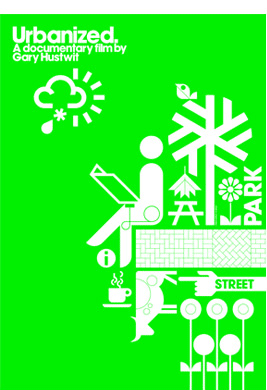
Main Topics Covered: Urban design and planning, city center evolution, urban installations, and strategic design solutions.
Quick Summary: Urbanized goes into detail about the design of urban spaces. It focuses on the challenges a city faces in the present and future. Most of these concerns are only tackled by the professionals, when in reality the public uses urban spaces the most, and they are unaware of certain problems. It shows many precedents and examples from around the globe. This movie will make you think next time you are driving down the street, or walking in your urban center, as “everything is designed.”
Landscape Architect Inspiration: Although the movie does not focus primarily on LA’s work, if you read between the lines it certainly does. LA’s are working with architects, urban planners, policy makers, and of course the public, more and more to design city projects. If we know what the other professionals are thinking and doing, and some of the restrictions they are facing, then it makes it easier for us to do our jobs and to provide solutions as a creative – and successful- whole.
To watch the preview, click here.
Lead image taken from Urbanized.
Urban Agriculture: 8 Landscape Architecture Firms Leading the Way
There are few landscape architecture firms today that can say Urban Agriculture Design is on their shortlist of services offered. Most firms are capable of designing a productive space, of course, whether or not they can say they specialize in this area of design is another matter. Below are eight North American Landscape Architecture firms that are leading the way through their own advocacy and stellar Urban Agriculture projects.
1. HB Lanarc – Vancouver & Nanimo, BC
Located on Canada’s west coast, this landscape architecture firm concentrates on sustainability, focusing on ways to design the “ecologically resilient, and prosperous communities” of tomorrow. HB Lanarc also has several specialties, one of course including urban agriculture. Their focus is a little more broad however, “Sustainable Food Systems & Agricultural Urbanism,” is the technical service provided. Designing urban farms is only one aspect of their speciality, they also provide policy, planning, and guidelines for food systems in cities.
In my first installment of the UA series, I listed the Top 4 Urban Agriculture Books, including Agricultural Urbanism. The author, Janine de la Salle, is the Planner and Food Agricultural Systems Specialist. She not only provides designs, but also works with municipalities to develop food strategies and policy, and shares her knowledge through lectures and workshops on urban agriculture.
In their portfolio is a project called ‘False Creek Urban Agriculture Design Guidelines‘. This project works on fitting productive landscapes into residential landscapes, and how food in the community can help redesign and rebuild a neighbourhood’s social and sustainable outlook.
Image courtesy of Vancouver.ca
2. Grow Studio (EOA) – New York, NY
At the offices of EOA (Elmslie Osler Architecture) there is a division called Grow Studio, which specializes in urban agriculture. Like the other firms mentioned in my list, Grow Studio brings added value to EOA and visa-versa, as they focus on integrating food systems into the “existing commercial, residential, and community and ivic parks.” EOA also specializes in architectural branding, so rest a sure that any urban agriculture project will be distinctive.
One cool project that is still in the works is called The Urban Farming Food Chain. It is a series of vertical growing spaces in the city, which create a continuous harvest of fruits and veggies. They also plan on adding a classroom and kitchen facilities in phase 4.
Image courtesy of EOA.
3. Urban Edge Studio – Mount Pleasant, SC
Bill Eubanks, the Creative Director for Urban Edge Studio (UES), recently spoke at LaBASH 2013 (a student run conference for students in landscape architecture) about designing urban agriculture. UES specializes in urban walkability, streetscapes, plazas and parks and pretty much anything else to do with the ‘urban-scape,’ and it just so happens that all their design beliefs support urban agriculture as well.
UES has done multiple urban agricultural projects, but one in particular, called the Medical University of South Carolina’s Urban Farm (MUSC), they worked on in collaboration with Crop Up. The landscape architectural and urban design skills of UES matched with Crop Up’s educational, inspirational, and planning background, made MUSC Farm a successful design. MUSC Urban Farm stands by the university’s mission to attain healthy lifestyles and to educate people, by adding classrooms, workshops, and food production and educational opportunities.
Image courtesy of Urban Edge Studio Blog
4. Crop Up – Charleston, SC
Crop Up is a consulting firm that specializes in creating “food projects in urban areas.” Founder Elizabeth Peak’s expertise and experience in permaculture and food education gives her the perfect edge in completing urban agriculture projects.
Image courtesy of MUSC Urban Farm Facebook page.
5. April Philips Design Works – San Rafael, CA
April Philips Design Works (APDW) focuses on places for people to escape and enjoy. The firm also specializes on the sustainability aspect of projects. Lead by April Philips, author of Designing Urban Agriculture, APDW offers the regular services of any successful landscape architecture firm, plus something special: urban agricultural landscapes and green roof design. Her credibility, expertise, and knowledge, give this firm an agricultural advantage.
APDW in conjunction with Miller Creek Middle School created the Miller Creek Edible Garden – a kid friendly, food focused, learning sanctuary right on the school grounds. The design focuses on experiential and hands on learning.
Image courtesy of Miller Creek Edible Garden Blogspot.
6. Kenneth Weikal Landscape Architecture – Farmington Hill, MI.
Kenneth Weikal Landscape Architecture is a well know landscape architecture firm, specializing in sustainability, horticulture, master planning, etc., and now, productive landscapes. The firm designed the famous Lafayette Greens Urban Garden in Lafayette, Detroit. This garden is in the heart of an under-utilized and forgotten section of downtown Detroit. Now the farm has revitalized the area and has allowed people to gain a sense of community and have a place to learn and interact with one another. Landscape Architecture Magazine (LAM) recently did an article on the farm in their April issue.
7. Nelson Byrd Woltz – California, New York, & Virginia
Nelson Byrd Woltz, the classic and quite recognizable landscape architecture firm (the one that designed one of my favourite public parks – City Garden), now does food landscapes. NBW recently just came out with a book called Garden, Park, Community, Farm which shows off selected works. The firm designed the Urban Farm of Charlottesville in a low income area with hopes to create a sense of community, access to fresh food, and to help educate the citizens about nutrition.
8. BASE Landscape – San Francisco & Berkeley, CA
“Landscapes are the physical manifestations of our values,” is this firms design philosophy. BASE Landscape wants to recreate what we as humans value the most, and they sure know that this is to sustain ourselves (or in other words… food). A fun and collaborative studio, BASE specializes in ‘foodscapes’ and a quick look at their portfolio will show you some of the groundbreaking projects they have been working on.
Once a former parking lot, the Bronx Roofpark is five acres of rooftop farm and playground – the ultimate oasis for food education with outdoor kitchens, recreational activities and play spaces to inspire New York City’s youth.
Image courtesy of BASE Landscape Architecture // Samantha Dabney. All images above courtesy of firm unless otherwise noted.
Do you know of other landscape architecture firms that specialize in urban agriculture projects? Let us know your favorite by leaving a comment below…
Vertical Growing: Garden Tower Project
With a vision of a world enhanced by easier gardening, healthier produce, and food security for all, the Garden Tower Project is on a mission to “allow individuals and communities to easily become more self-sufficient, sustainable and ultimately create a more resilient local economy.”
The Garden Tower unit has over 45 plant openings and yields hundreds of veggies in just 4 square feet. Using a special recycled composting method, the veggies that grow in the Garden Tower use considerably less water then conventional growing methods. The middle part of this preassembled structure creates its own ‘worm-activated’ compost simply by adding your own kitchen scraps and worms. The added benefits of the worms – a perfectly aired soil, and the creation of vermicompost and microbes – allows this to become the perfect growing medium for plants.
The Garden Tower team envisions this growing structure to be an answer to the food desert. “Distributed agriculture is key to local economic community resilience. Our only goal is to help people achieve a cheap easy and convenient way to grow their own clean, healthy and organic food,” says co-founder Tom Tlusty.
Watch the video below to learn more about the creative design of the Garden Tower.
The height of the Garden Tower creates ease of use to people with physical limitations, allowing anyone to sit or stand while harvesting and planting. This means it is great for public environments, community gardens, and as an education tool. The size and aesthetic of the Garden Tower make it easy to fit into any urban setting – inside or outside – whether on a single balcony in the city, a few in an office building, or even a whole group of them in a neighbourhood farm.
Tlusty’s message to help further the urban and suburban agricultural movement is through, “support of local organic producers, farmers markets, community gardens, orchards, seed libraries and banks.” He also is a strong advocate for, “planting only Organic Heirloom & Non-GMO fruits and vegetables,” and believes, “education is paramount to the coming wave.”
With products like this one, it is easy for landscape architects to design a food producing space and specify this amazing product. Now, it is also easier for everyday people to think differently about where their food comes from, and how they can solve the current food problem. This designer and writer is sure looking forward to getting one!
Go to their website to learn more, and support the local food movement.
Top 4 Urban Agriculture Books for Landscape Architects
Yes, the internet has multiple learning outlets and an endless supply of websites, but books have that certain familiarity and dependability that we all gravitate back towards. There is nothing quite like the feel of turning a real-life page, so that is why my first installment in the UA Series is about books! Below are my Top 4 page-turners about designing urban agriculture that belong on every designer’s shelf:
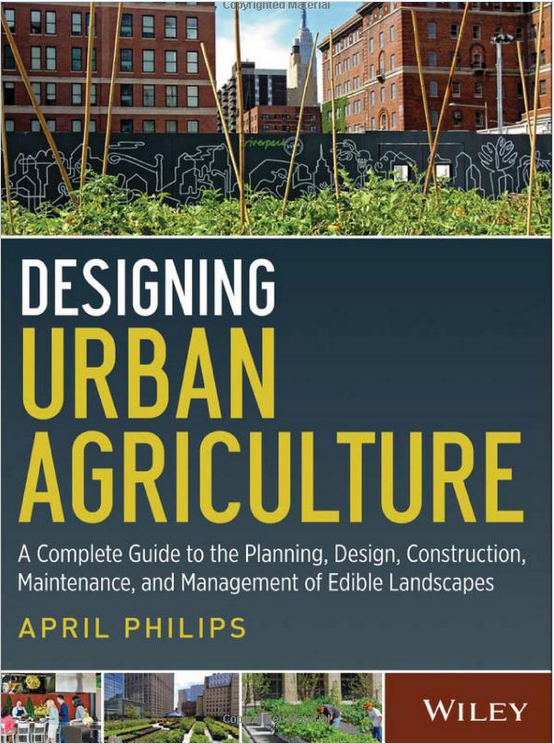 #1: Designing Urban Agriculture: A Complete Guide to the Planning, Design, Construction, Maintenance and Management of Edible Landscapes by April Phillips
#1: Designing Urban Agriculture: A Complete Guide to the Planning, Design, Construction, Maintenance and Management of Edible Landscapes by April Phillips
Phillips’ book starts with an ecological background, and shows how food systems can be integrated back into the city. Exploring the relationship between makers and eaters, Designing Urban Agriculture, shows projects from around the world that incorporate all aspects of food including: street scape farms, plazas, community gardens, public farms, vertical walls, edible schools yards, and so much more… Her book also realizes that sustainable food systems are a lot more than just watering and weeding; showing you how to ‘do’ UA from start to finish, with information on: design, budget, construction, sustainability, and business and marketing. Check out our Member Spotlight interview with April Philips where she tells in detail about her design philosophy and new book.
 #2: Carrot City: Creating Places for Urban Agriculture by Mark Gorgoleski, June Komisar, and Joe Nasr
#2: Carrot City: Creating Places for Urban Agriculture by Mark Gorgoleski, June Komisar, and Joe Nasr
Over the past year Carrot City has been my UA bible – I have referred to it for just about everything. The book is divided into four sections based on where food can be applied: productive cities, building communities, the home, and the roof. It also features a section on growing components, (vertical screens, container gardening, hydroponics, etc.) and how they can by applied in your own home or community farm. Carrot City is an inspirational book, with all of its glossy images, it is sure to leave you with a ton of inspiration for your next project. The authors did a great job of making sure this book has a positive spin on incorporating food systems into our lives, and that we are still able to contribute to the revolution.
Cover Image Courtesy of Ryerson
 #3: Continuous Productive Urban Landscapes: Designing Urban Agriculture for Sustainable Cities by Andre Viljoen
#3: Continuous Productive Urban Landscapes: Designing Urban Agriculture for Sustainable Cities by Andre Viljoen
This was one of the first books to be released about urban agriculture and it’s incorporation into cityscapes. Continuous Productive Urban Landscapes (CPUL) is a relatively new term, that describes the connection of ready-to-harvest and green-scapes that runs throughout the city, much like those green corridors and patches that we all strive for in our designs, but this time to include produce! CPUL’s is more of a text book, and proves to be a great resource in defining CPUL’s, and their history. Viljoen’s book also includes concepts, strategy planning, and a variety of different case studies and sections from other writers, to help introduce CPUL’s into your city.
 #4: Agricultural Urbanism: Handbook for Building Sustainable Food Systems in 21st Century Cities by Janine de la Salle and Mark Holland
#4: Agricultural Urbanism: Handbook for Building Sustainable Food Systems in 21st Century Cities by Janine de la Salle and Mark Holland
Take the bones of food production and add all the facilities: business attributes, learning and programming opportunities, etc., and you get this book. Agricultural Urbanism goes into detail about all of the other things that landscape architects are involved with that are still important in the food industry, even when the design is complete. It breaks down the different areas where food production can take place, and goes further into food processing, organic wholesale business, and education and training programs and opportunities.
Cover Image Courtesy of Green Frigate Books
Do you know of any other books that have helped you design UA or are an inspiration?
Vertical Garden System at the Screen House | San Francisco, CA
Dubbed the ‘Screen House’ for its a steel armature woven with VIRO polyrods that screen the main street aperture, this award-winning residential project in San Francisco by A+D, was showcased at the 2010 San Francisco Living Home Tours. With the use of the vertical garden system by Inka Biospheric Systems, this application shows the versatility of the living wall in a dense residential neighborhood. See photos below…
Inka Biospheric Systems designs custom living wall systems for residential, commercal, educational, and agricultural systems.
Architect: A+D, Sandra Vicanco
Landscape Designer: Julie Trachtenberg
Product: Inka Biospheric Systems
Images: All photos courtesy of Kat Taylor.
PLAYscapes Competition: Which city is the most fun?
For all the adults (and young adults) out there who still have that nagging urge to climb a tree, play hop scotch, or swing at the playground, here is an opportunity to let your imagination go wild. PLAYscapes design competition, brought to you by Building Trust International, is a competition for the kid at heart who wants to make their city more playful.
The goal – to transform any abandoned urban area [in your city] into a playful landscape. Imagine a slide outside of a grocery store, a swing at bus stop or even a maze in a public plaza? Nothing is to crazy for the jury. Anyone and everyone are free to enter. Let the fun begin!
Important Dates:
Registration Deadline: July 1, 2013
Closing Date for Submissions: July 29, 2013
Check out the brief: http://www.buildingtrustinternational.org/PLAYbrief.pdf
Image Credits
Lead Image: Via This is Colossal
Maze: Via En Derin
Ron Finley: Flipping the Script on Gardening in South Central LA
South Central LA is home of the “drive-throughs & drive-bys”, says Ron Finley in his TED Talk about gardening. He believes that with more people dying from from preventable diseases, rather than shootings, Ron used the long-strip boulevard by his home to create food gardens that the community can access and be part of developing.
Check out the video below, and discover how “Planting some S***”, turned a desert green.
Learn more about Ron Finley’s movement at lagreengrounds.org
Love to hear what you think! Leave your comments below…
We’re Over: Breaking Up the Long Distance Relationship with Your Food
“We’re Over: Breaking Up the Long Distance Relationship with Your Food,” was the title of my undergraduate thesis. My thesis was about local food and designing Urban Agriculture (UA), so I came up with this concept of “Breaking Up” that everyone would be able to relate to and understand. Most of us are currently in a long distance relationship with our food. We wouldn’t want our partner taking advantage of us or making us more physically or emotionally unhealthy would we? It’s the same with our food.
The average piece of food travels 2000 km (1242.75 miles) from where it is grown to where it is consumed. The long travel time not only affects the health of the food by diminishing the nutrients in fresh produce, but most produce is sprayed with additional chemicals to help it look falsely appealing and fresh when it reaches your grocery store. It also affects the social aspect of our local communities by obscuring the connection between who is growing our food and who is eating it. This is why local, sustainable food is so important. If our food travels short distances from local farms or community gardens, then it supports local, often organic growers, is better for the environment, and people can become more educated and connected with where their food is being grown.
Gary Comer Youth Center, Rooftop Garden, Designing Urban Agriculture by April Philips (Wiley 2013)
Urban Agriculture has grown into a world wide farming phenomenon, and it won’t stop because, well… we all need to eat. My research on the subject has opened my eyes to all of the negative things that are going on in the food industry today, but it has also given me inspiration and hope for what can be done to fix many of these problems. So, I thought why not inform everyone on the best tools, resources, books, and guides available to make it easier to design Urban Agriculture in your community.
With this said, I am starting a UA series. Through all of my research I gathered tons of interesting information that I am excited to share with you all. Once a week I will post an article with beneficial resources, advice, and inspiration to help you start considering the design and implementation of UA spaces.
Here is a list of topics:
1. Top Books on Designing UA
2. The Best Products for Designing UA
3. Top 10 Successful World Wide UA Projects
4. Design Resources for UA (Software, Guides, etc.)
5. Top Inspirational Movies & Campaigns for Designers about UA
6. Why Landscape Architecture can help the Global Food Problem
7. Urban Ag Events & Campaigns
8. Current & Future UA Projects
9. UA & Landscape Architectural Firms
+ More to Come!
Is there a topic within Urban Agriculture that you would like me to cover? Please feel free to leave suggestions in the comments below.
Look for the first in the series next week!
Image Credit: Courtesy of April Philips and Wiley
Graphic by Author


